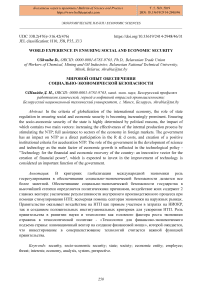World experience in ensuring social and economic security
Автор: Shvaiba Dzmitry
Журнал: Бюллетень науки и практики @bulletennauki
Рубрика: Экономические науки
Статья в выпуске: 9 т.5, 2019 года.
Бесплатный доступ
In the criteria of globalization of the international economy, the role of state regulation in ensuring social and economic security is becoming increasingly prominent. Ensuring the socio-economic security of the state is highly determined by political reasons, the impact of which contains two main vectors: increasing the effectiveness of the internal production process by stimulating the NTP; full assistance to sectors of the economy in foreign markets. The government has an impact on NTP as direct participation in the R & d costs, and creation of positive institutional criteria for acceleration NTP. The role of the government in the development of science and technology as the main factor of economic growth is reflected in the technological policy - "Technology for the financial and economic recovery of the country: an innovative vector for the creation of financial power", which is expected to invest in the improvement of technology is considered an important function of the government.
Security, state, society, economic entity, employee, threat, interests, economy
Короткий адрес: https://sciup.org/14115682
IDR: 14115682 | УДК: 338.2(476)+316.42(476) | DOI: 10.33619/2414-2948/46/31
Список литературы World experience in ensuring social and economic security
- Schott P. K. The relative sophistication of Chinese exports // Economic policy. 2008. V. 23. №53. P. 6-49. x DOI: 10.1111/j.1468-0327.2007.00195
- Puga D., Trefler D. Wake up and smell the ginseng: The rise of incremental innovation in low-wage countries. National Bureau of Economic Research, 2005. №w11571. DOI: 10.3386/w11571
- Shvaiba D. Dynamic regression models of forecasting indicators of social and economic security // Бюллетень науки и практики. 2019. Т. 5. №1. С. 249-257.
- Shvaiba, D. (2018). Industry of the Republic of Belarus: problems of social and economic security // Бюллетень науки и практики. Т. 4. №9. С. 245-252.


